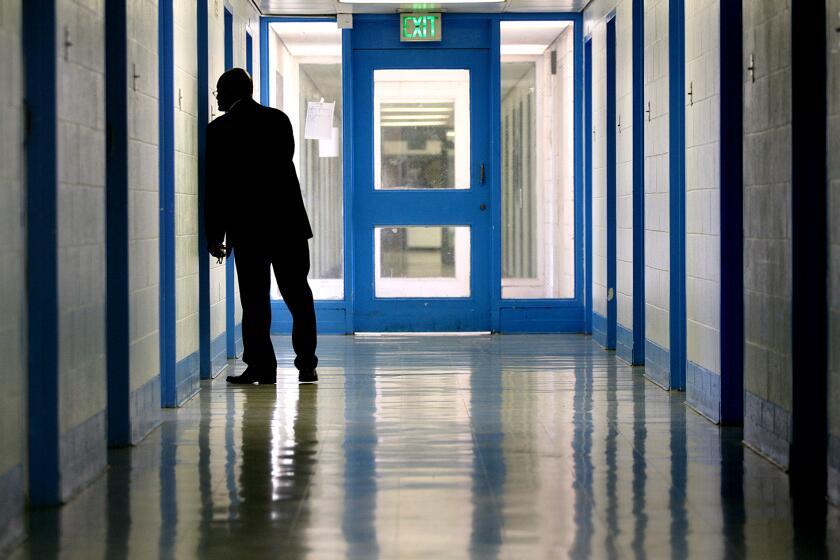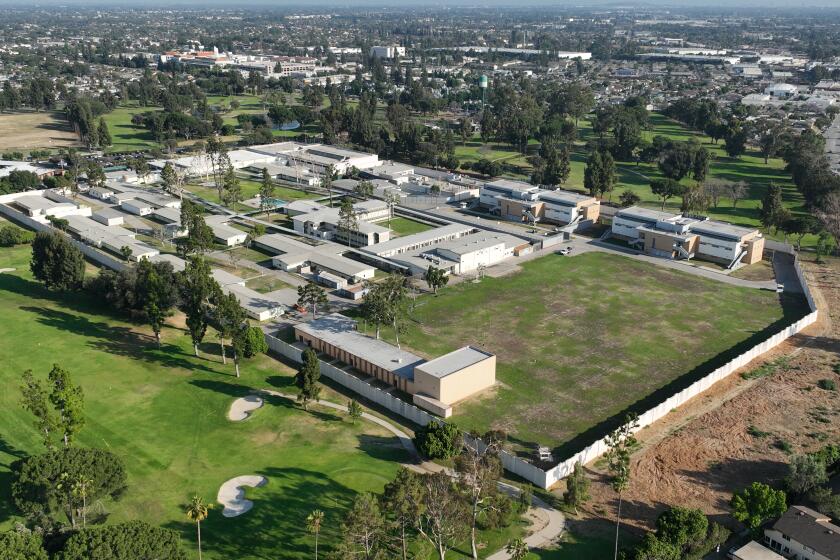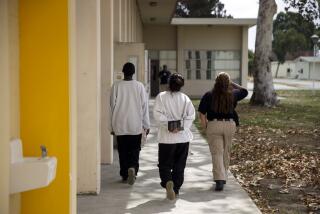From ‘mission accomplished’ to riot: Inside the chaotic first month at Los Padrinos

- Share via
Nine days after Los Angeles County’s top probation official declared “mission accomplished” for transferring nearly 300 youths into the reopened Los Padrinos Juvenile Hall, police and news helicopters were circling the facility.
Seven youths had smashed apart a table and used the pieces as weapons, attacking staff and attempting to break out into the streets of Downey, according to an internal summary of the incident obtained by The Times. One teen briefly escaped to a neighboring golf course and several officers were injured in the melee.
Interim probation chief Guillermo Viera Rosa had touted his department’s success on July 19 after carrying out the state-mandated transfers in less than two months. But the brawl and chaotic escape attempt were not the first signs that the Probation Department’s long-term struggles to safely care for youth may have carried over to Los Padrinos, according to a review of internal department documents, interviews with multiple probation officials who have worked at the facility and parents of children housed there — all of whom requested anonymity because they are not authorized to speak publicly or fear repercussions for incarcerated youth.
A week before the riot, the discovery of a gun in a staff member’s office forced a facility-wide lockdown. Kids who were trapped in their rooms for hours with no bathroom access resorted to urinating and defecating on their beds while officers searched the facility for contraband, according to probation officials and parents in contact with their children at Los Padrinos.
Some county leaders have brushed off the recent incidents as growing pains, the inevitable aftermath of moving roughly 270 youth, mostly ages 15 to 18, into new surroundings on a tight timeline. They’re optimistic that the new start will mark a turning point for a department where records show some officers are routinely not showing up for work.
While Los Padrinos is not brand new — it was shuttered in 2019 amid abuse allegations and a shrinking population of incarcerated juveniles in L.A. County — it is the most modern of the county’s three juvenile halls. Probation officials hoped the shortened commute for officers who lived in the South Bay and normally traveled to facilities in downtown L.A. or the San Fernando Valley for work would improve staffing levels.
But in an Aug. 3 internal memo, Viera Rosa made clear the situation remains dire.
“Callouts and no shows continue at an unacceptable rate. Many staff continue to shirk their duty as if they don’t believe we are in an institutional emergency,” Viera Rosa wrote. “They act as if they don’t care that by failing to show up, they are placing an undue burden and risk on their colleagues who do.”
The county began scrambling to reopen Los Padrinos in May after California’s Board of State and Community Corrections (BSCC) ordered most youths out of Central Juvenile Hall in downtown L.A. and Barry J. Nidorf Hall in Sylmar, citing repeated failures to improve conditions. Now, after a little over a month of operations in a facility that was supposed to be new and improved, BSCC investigators are again raising alarms.
State regulators had given L.A. County multiple opportunities to bring the juvenile facilities in Sylmar and Boyle Heights into compliance.
State inspectors issued a report Aug. 18 that said some youths were urinating in their rooms at night because there were not enough officers on hand to let them out to use the bathroom. According to the report, staff said they were being asked multiple times per week to stay and cover shifts for colleagues who hadn’t shown up. The report found the facility to be in violation of a dozen state regulations, and noted that staff had not been trained in the department’s use-of-force policy.
The county has until mid-October to craft a plan to fix the problems.
“Their definition of mission accomplished was very limited,” said Eduardo Mundo, a member of the L.A. County Probation Oversight Commission, who toured Los Padrinos the day the gun was found. “Every time I want to plan a visit, there’s a crisis over there. It’s ridiculous.”
The Probation Department declined to respond to a detailed list of questions about conditions at Los Padrinos. The agency previously rejected a request to allow reporters to tour the facility.
Some elected leaders say their hopes for a new chapter for the Probation Department are already dashed. County Supervisor Janice Hahn, whose district includes Los Padrinos, said she had personally urged the Downey mayor and City Council to accept the facility reopening, a campaign she’s now growing to regret.
“I had high hopes for Los Padrinos. It was a new start. We had that facility spick and span,” said Hahn. “I’m disappointed in everybody.”
Initially, the opening of Los Padrinos appeared smooth. A report from the county Inspector General’s Office noted one youth trying to kick open a vehicle door during the mid-July transfer, with no other incidents.
But according to two probation officials who have worked shifts at Los Padrinos and spoke anonymously for fear of reprisals from their employer, the facility was not prepared to house kids despite receiving a green light from state regulators to open.
Some rooms were “out of order” because their doors or toilets were malfunctioning, the officials said, and plumbing issues left other units without hot water. Linen and clothing weren’t readily available and dead roaches were found in some rooms, according to the officials.
There were “no chairs, books, basketballs, trash cans … there wasn’t anything. They just threw us over there. Nothing was set up for these kids,” one of the officials said.
Limited access to recreation time and educational programming can fuel violence in juvenile halls, according to researchers who study incarcerated youth, and those familiar with the current staffing levels at Los Padrinos are concerned kids’ needs are not being met. The BSCC report found that youth were not being provided “age-appropriate, stimulating recreational activities to engage in.”
More than a quarter of the department’s employees who work in the juvenile halls were out on leave or on “light duty” due to physical restrictions as of late 2022, records show.
Earlier this month, Viera Rosa ordered those on light duty to report to Los Padrinos, promising they’d be put in roles that wouldn’t require interacting with youths, according to the memo. Those who refused were threatened with discipline, according to a high-ranking department official and a union official with knowledge of the situation, both of whom requested anonymity to discuss personnel matters candidly.
On July 21, just days after the youths moved into Los Padrinos, officers found a gun in a staff office commonly referred to as a control center, which the two officials who’ve worked at the facility said was at the center of a unit that houses developmentally disabled youths.
Just days after youths were moved into Los Padrinos Juvenile Hall, probation officers found a gun in an area potentially accessible to youths, sources said.
The incident triggered a lockdown as police searched the building for other weapons. Youths, lawyers and educational staff reported being trapped in rooms for hours with no information about what was happening.
Bringing a firearm into a juvenile hall is illegal and the case is under investigation by the Downey Police Department, which declined to answer questions citing the pending investigation.
The two Probation Department sources said the weapon was a supervisor’s personal firearm that was brought inside during the move from Central or Nidorf. The supervisor has been placed on administrative leave, one source said.
The department declined to answer questions about how the weapon ended up in Los Padrinos. A spokesperson previously insisted the gun was in an area that could not be accessed by juveniles. But the two probation officials who’ve worked at Los Padrinos said youths often receive counseling in the type of control center where the gun was found, and one said the doors to such areas aren’t always locked.
One week later, probation officers were again scrambling to deal with a crisis at Los Padrinos. This time, just after 7 p.m. on July 28, an officer radioed for help, citing “racial tension and hints of something bound to happen,” according to the internal incident summary obtained by The Times.
Within minutes, youths began covering security cameras with tape and a group tried to break into one teen’s room to assault him, the document said.
One youth had to be wrestled into an office to stop an assault, according to the document, and others were locked in a bathroom. One youth demanded the others be set free and began counting down to zero. When the demand wasn’t met, he punched an officer in the face, the document said.
Over the next half-hour, brawls between youth and staff broke out across the unit. Detainees hurled chairs over stairwells and seven of them tore apart a desk and used the pieces as weapons against officers, according to the document. Some tried to break into a neighboring unit to attack other detainees.
“The entire day room became a large fight, with staff desperately trying to prevent minors from attacking staff,” the report read.
Several youths got out of the building and into an outdoor recreation area, according to an internal email reviewed by The Times. One got over a back gate and made it onto the grounds of Los Amigos Golf Course, which surrounds Los Padrinos on three sides, before he was apprehended by probation officers.
At least one officer suffered a broken arm and broken hip in the brawl, according to a probation union official who requested anonymity to speak candidly about officers’ medical histories. Two others were hurt after youths beat them with pieces of the desk, the official said.
Two of the youths allegedly involved in the brawls — Xavier Perez, 18, and Frankie Dale Hoope, 19 — were charged with four counts of assault, court records show. Perez was charged with additional counts of weapons possession inside a juvenile hall and attempting to escape from custody, according to a criminal complaint.
Both pleaded not guilty, according to Venusse Navid, a spokeswoman for the district attorney’s office, who said the victim of each assault was a probation officer. Perez’s attorney did not respond to an e-mail seeking comment and Navid did not identify Hoope’s legal counsel.
Viera Rosa banned the use of chemical spray to control detainees in Los Padrinos when he became interim chief in May, but reauthorized it after the disturbances.
The reversal further delays efforts by county leaders to permanently end the use of spray following repeated allegations of misuse by officers. In the nine days after the riot, spray was used nine times, mostly in instances when youth were assaulting staff or each other, according to a deployment report.
One officer insisted that breaking up fights is nearly impossible without the chemical spray, especially in large brawls.
“A lot of times it wasn’t even spraying the kids, it was just giving the warning,” said the officer, who was not authorized to speak to the press and requested anonymity.
Late last month, a coalition of groups temporarily shut down a Board of Supervisors meeting over calls to “declare an emergency” over the conditions inside Los Padrinos, with some advocates calling for a permanent closure.
“It feels like the county’s playing musical chairs with dangerous facilities,” said Emilio Zapien, one of the demonstration’s organizers with the Youth Justice Coalition. “It’s the same problem moving from one location to another.”
Probation Oversight Commission member Sean Garcia-Leys said at a recent commission meeting that he fears Los Padrinos is already headed for the same fate as the county’s other juvenile halls.
“I see in six to nine months, [the state board] shutting down Los Padrinos unless there is something radically different done,” he said. “And I don’t see any plans to do anything radically different.”
More to Read
Sign up for Essential California
The most important California stories and recommendations in your inbox every morning.
You may occasionally receive promotional content from the Los Angeles Times.














